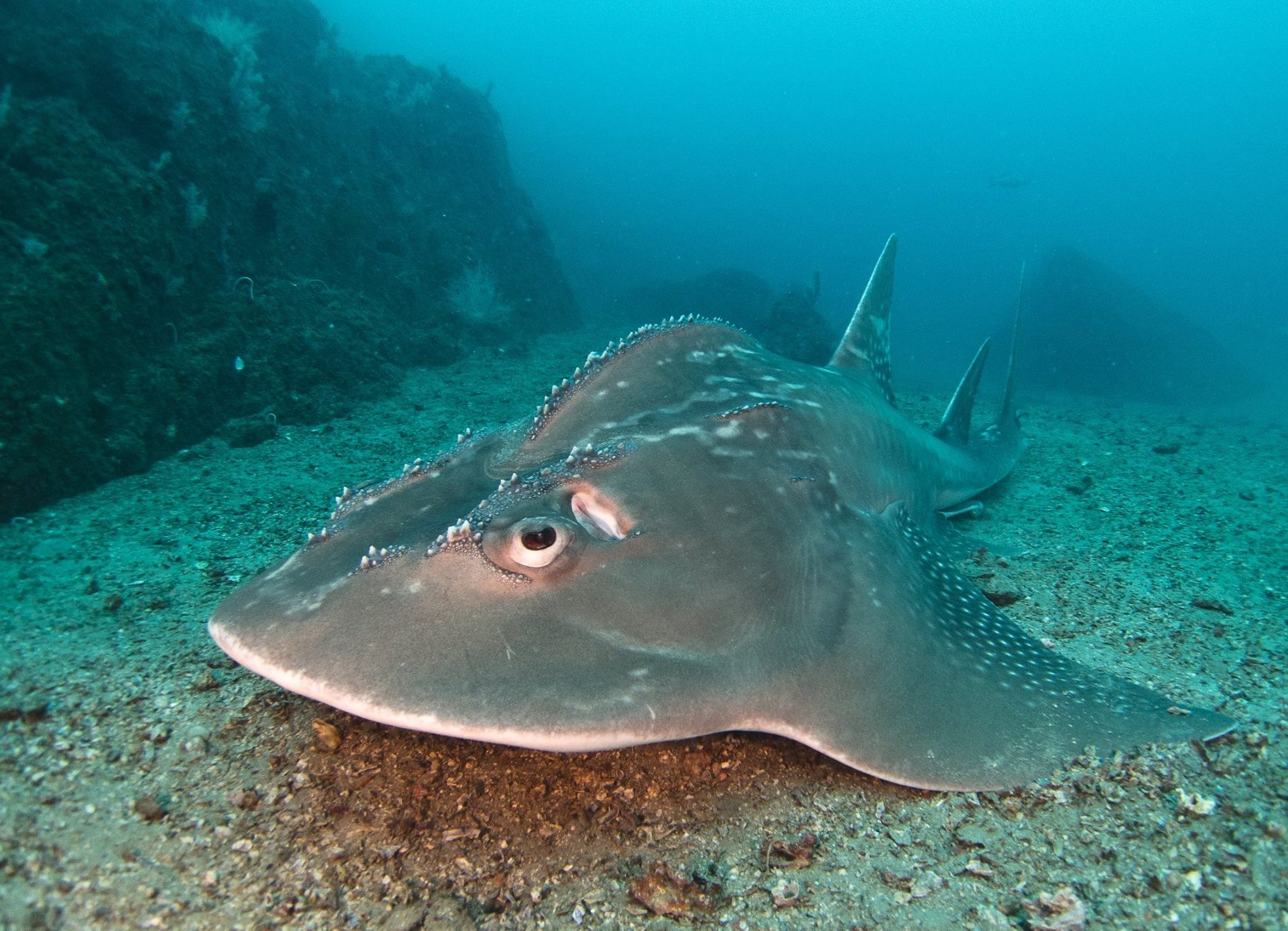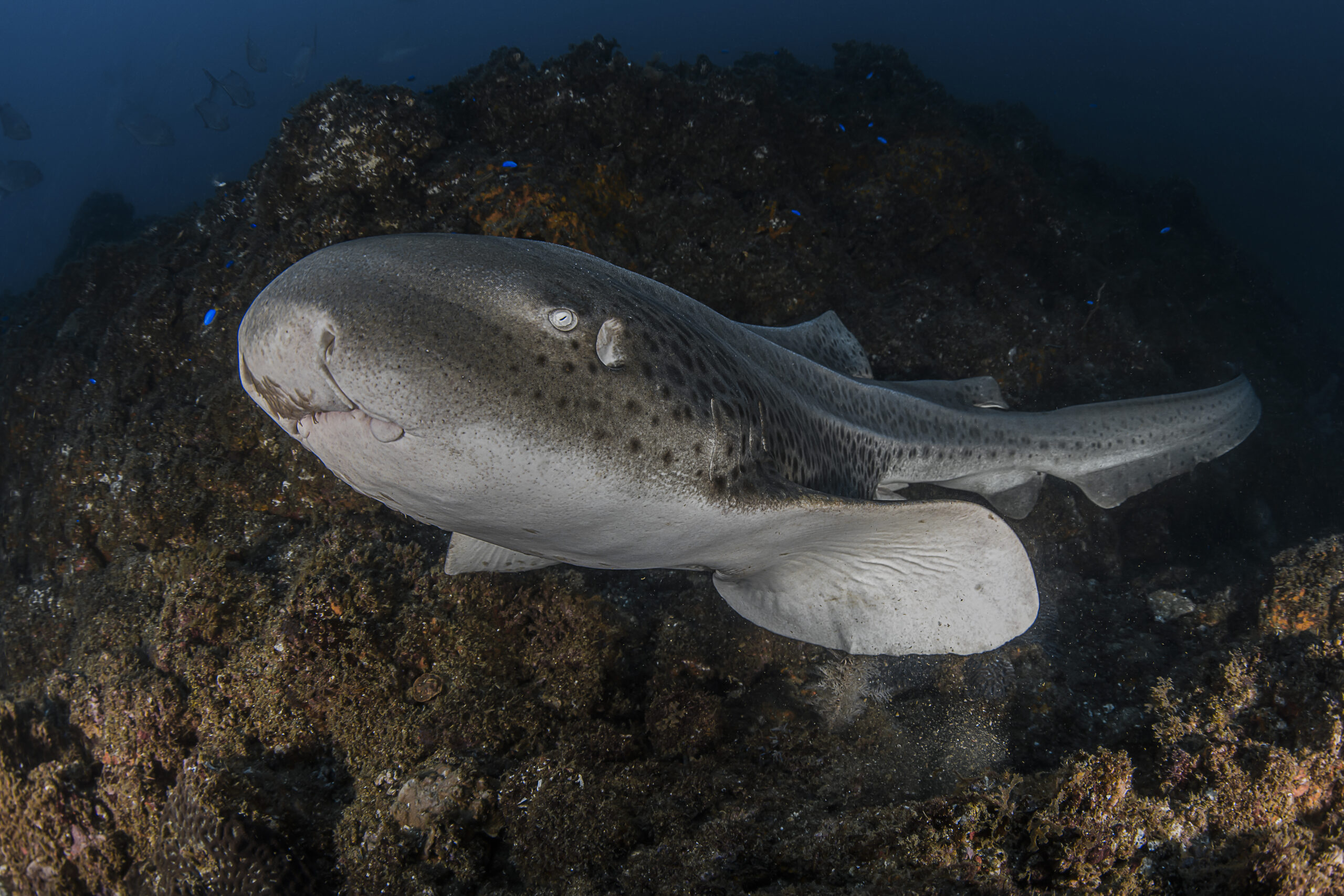Dive sites
wolf rock
“Australia’s Best Shark and Ray Dive”
It is believed that Wolf Rock was given its name by Captain Cook who had a Lieutenant Wolfe onboard the HMS Endeavour. The two pinnacles that break the surface regardless of the tides would have represented a significant navigational hazard for early seafarers.
We now know that Wolf Rock is just the tip of a large site made up of a series of volcanic pinnacles, gutters, and gulley’s some as deep as 38m. Located just 2km off Double Island Point it is the last significant rocky outcrop before Fraser Island, the largest sand island in the world at.
Essentially an oasis in a desert, animals from all over the East coast of Australia come to Wolf Rock to be cleaned, to breed, to seek shelter, and to eat!
Another reason for the abundance of marine life at Wolf Rock is the current. The currents are always stronger in the summer and are ideal conditions for large animals to gather in. The flow of water over their gills keep the animals well oxygenated.
If the current is running, you can bet it is going to be an exciting dive!
Visibility at Wolf Rock ranges from 5-50m and is very unpredictable! There doesn’t appear to be any season that it is noticeably better than any other. Visibility can change very quickly at Wolf Rock but on an average day, you should expect 10-15m.
Due to the Depth, Currents and Visibility Wolf Rock can be a challenging dive site. You don’t have to be a really experienced diver to enjoy Wolf Rock but you should be a reasonably competent diver. We take pride in ensuring that divers of all levels are well prepared to safely enjoy the wonders of Wolf Rock!
Winter VS Summer at Wolf Rock
- Temperatures can be as high as 27 C in February and as low as 19 C in August.
- Winter surface conditions are generally a lot nicer than in the summer months although we do recommend sea sickness tablets be taken throughout the year.
NOTABLE ANIMALS AND WHEN THEY CAN BE SEEN
Grey Nurse Shark Carcharius Taurus
All year Around
These animals are breeding and gestating at Wolf Rock, please refer to the Grey Nurse Shark link above for more information.
Greater numbers are observed between December and July.
Max Size 3m
Considered Harmless
Leopard Shark/Zebra Shark Stegostoma Fasciatum
November/March
These animals migrate between the Barrier Reef in the winter and as far South as Byron Bay in the summer. We have daily sighting of these animals between Nov-March.
Max Size 2m
Considered Harmless
Reef Manta Ray Mobula Alfredi
March-October
These animals migrate between The Great Barrier Reef in the winter and as far South as Coffs Harbour in the Summer.
They come to Wolf Rock to be cleaned and we see them on approximately 50% of our dives between March and October
Max Size 5m.
Considered Harmless
Eagle Ray. Myliobatidae
All Year Around
These animals are resident to the Wolf Rock region and can be observed throughout the year. We typically get the large schools (fevers) of up to 100+ animals between August and February
Max size 3m.
Considered harmless
Queensland Grouper Epinephelus Lanceolatus
All Year Around
These animals are resident to Wolf rock and can be observed throughout the year. We do get a Grouper aggregation at Wolf Rock during the full moon in November.
Max length 3m.
Max weight 500 kg!
Considered harmless.
Blotched Fantail Ray/Bull Ray. Taeniurops meyeni
All Year Around
These animals can be observed throughout the year at Wolf Rock. They do aggregate in large schools (fevers) during the summer months when the current is running
Max width 2.5m.
Considered harmless unless you ride them!
Olive Sea Snake Aipysurus Laevis
All Year Around
Olive Sea snakes can be observed throughout the year at Wolf Rock, they are highly venomous but thankfully for divers, extremely docile!
Max Size 1.5m
Considered harmless
Humpback Whales Megaptera novaeangliae
June to October
During winter we witness the annual migration of the Humpback Whale.
These majestic giants migrate to the warmer coastal waters of Australia to give birth and to mate. We see large numbers of Whales from the boat every day and if you are lucky you might spot one of these submarine size mammals swim past during your dive!
Max Size 18m
Max weight 40 tons!
Considered harmless
OTHER THINGS TO SEE
With so much Megafauna swimming around the site it is easy to forget the smaller animals that also call Wolf Rock home. The site is home to a myriad of Pelagic, Tropical and Sub-Tropical reef fish with the regular sighting of three different species of Sea Turtle.
If you are interested in the wonderful world of Macro diving there is plenty to see at Wolf Rock! The site is covered in Soft and Hard Corals, Nudibranchs, Moray Eels, Scorpion Fish, Stone Fish, Ghost Pipe Fish, Sea Apples, Frog Fish, Octopus and Mantis Shrimps!






round rock & nursery reef
Round Rock is located in-between Wolf Rock and Double Island Point. It is a Shallower dive than Wolf Rock with a maximum depth of 16metres. Although you don’t normally find Grey Nurse Sharks at Round Rock it a very reliable place to see a number of different Ray species including Cow Tail Rays, Whip Rays, Blotched Fantail rays, Shovel Nose Rays and the rarely sighted Leopard Rays.
On an average dive at Round Rock you should expect to see at least 15 Rays!
Round Rock is a comparatively small site and not ideal for large groups.
